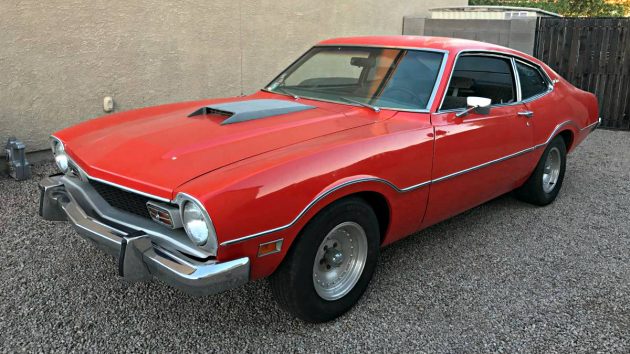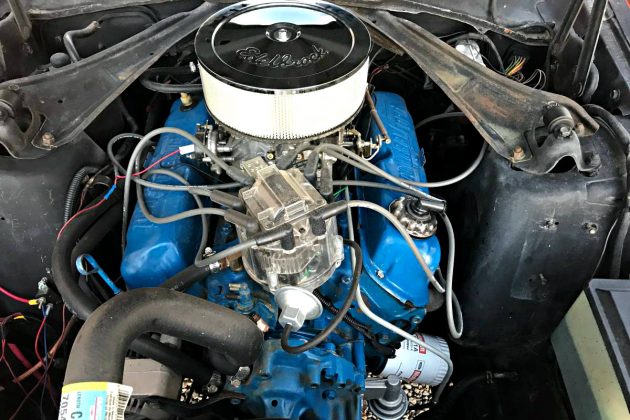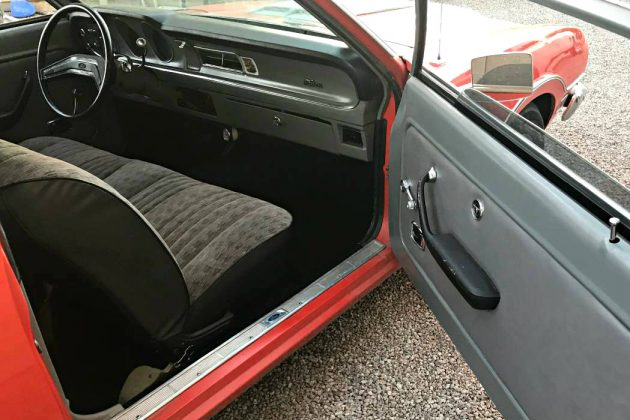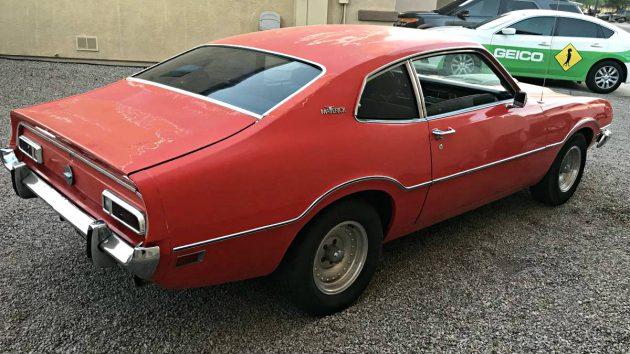Ford Mavericks are great cars that have been modified, raced, and even restored. Original surviving examples are always nice to see, but let’s be honest. Who wants a 6 cylinder Maverick when we all know that a V8 fits so nicely? Well that is exactly the sentiment this seller had with ’73. Very clean inside and out, this car has received a clean and well executed V8 swap. Road tested, and needing nothing, this Maverick is offered for $3,750! Check it out here on craigslist out of Queen Creek, Arizona. Thanks to reader Rocco B, for this clean surviving equestrian!
The owner did right by this nice condition car, by performing a clean and beautiful swap. The 302 V8 is mated to aC4 auto and has apparently made quite the long trek to Texas and back. An aluminum radiator, electric cooling fan, and “upgraded” alternator were all recent additions upon the long and sweltering trip to Texas. Painted nicely, the engine presents well, and looks like a pleasure to work on as it isn’t covered in oil and dirt. I guess the only gripe I have is this car is a manual steering, manual brakes vehicle. Now that the swap is complete and running smooth, I would at least opt for power assisted disk brake and possibly hooking up the air conditioning system again as this is a factory a/c car.
Simple, and clean, this Maverick looks to have been a nice survivor condition car until receiving its swap. The interior is simple, but very tidy with only minor signs of age and wear. The glove box doesn’t align quite as well as it should, but I imagine with some tinkering it could be realigned. A small tachometer has been fitted to the steering column to keep tabs on the engine. All in all, the interior is quite nice for the price.
Being an Arizona car is a bonus as this Ford appears rock solid with no signs of rust. The paint appears to be original having held on well for 44 years although the clear is starting to fail and chip off on the roof and trunk lid area. Beyond the paint issues, the body looks excellent and very clean. The body trim is virtually perfect, and the bumpers are in nice condition as well. The only issue to point out on the body is a small ding in the driver quarter, where the paint chipped and a small area of surface rust has formed. As far back as the dent is, I would think it could be accessed from the trunk, and possibly be pushed out, or worked on, as the quarter panel is not creased. Clean with a great potential to be a fun and affordable project, this Maverick seems like a no brainer. Would you pick up this clean affordable classic?






Not shabby! For the price I could consider becoming a Ford guy.
Guys, I didn’t want to say anything because I like your column but I have to tell you – these old ones virtually never had clear coat. I worked for years in a body shop so I do speak from some personal experience. Love the column though.
Yep, I had a red ’77….no clear coat was on it, and it was bought new by my dad, so I know it was original paint.
Clear coat generally wasn’t used by the manufacturers until around 1984. That’s just normal, burnt, failed paint.
Nice find. You can’t buy much nowadays for $3750.00.
My late wife and I bought one of these in
1987 as a used car, paying $1,200.00 for it. Ours was a 4-door model with most of the luxury options such as A/C. factory AM/FM stereo with 4 speakers, leather
interior with reclining front bucket seats,
vinyl top and side trim, and that wonderful powerful 302 V8. .Ours cranked out 230 HP with the aid of a 4-bbl carburator and dual exhausts. My FIL
loved driving my car ANY chance he got. He used to take great delight in romping
on the gas pedal when the situation presented itself. In fact, my wife won a
street race when she beat a Trans Am by
half a car length. We all do stupid things,
and in July of ’88, we traded it off for an ’86 Escort wagon, which we let go in 1990 when it turned out to be a lemon.
I’ve seen several very nice Mavericks on
your site and look back very fondly to our
Tan and White bomb and all the enjoyment it brought us.
Nice car but that’s a deteriorating repaint. Pretty sure no clear coats in the early 70’s.
The poor mans Mustang! I’d take this in a heart beat. Repair the damaged panel, install a Grabber hood, a new coat of paint, then off to the cruise-in. One question though, What’s with the GM HEI distributor?
There are several cheap white box Chinese electronic distributors patterned after the GM HEI, its probably one of those.
Steve R
I think this is a bargain, you just can’t get in to the hobby this cheap without a ton of bodywork. I wish it was closer I would be taking a look. That GM HEI may just be the aftermarket version DUI which they make to fit any make / model.
Clean car.
I’d put a Ford distributor in immediately. I like the hood with the Ford hood scoop over the Grabber hood. Just personal opinion.
Fantastic price. I know when it gets to old vehicles, one shouldn’t be picky. But the column shifter just looks strange to me. I feel like the car also wishes it had a floor-mounted shifter, even as an automatic! But like I said, beggars can’t be choosers and that $3750 is a small price to pay for a great looking car!
Am I correct in saying he steering wheel is 1975 or newer? They were straight across in Ford models 1974 and earlier.
It’s going to need that AC hooked up if the new owner is planning on keeping it in AZ. We’re currently under an Extreme Heat Warning for ten days in a row. The high is going to over 115 for several days. Other than that it’s a great car for $3,750
1924 – Spray painting was introduced and the only available material was nitrocellulose lacquer.
1929 – Alkyd enamel was introduced. It was tougher than lacquer and needed no compounding. Most manufacturers used either lacquer or enamel from this point on, depending upon availability and factory conditions.
1940 – Chrysler and Ford changed over to enamels exclusively. Metal flakes in paints were introduced by the aluminum industry.
1956 – Acrylic lacquer was popularized due to its better sheen and durability. GM went exclusively to the material.
1960s – Paints utilized chromates, lead and other heavy metal chemicals that produced durable finishes. Ford called its enamels “porcelinized” paints.
1970 – The first aftermarket polyurethane enamel, Imron, was introduced by DuPont. It utilized a two-part chemical system that was extremely durable. DuPont experimented with waterborne solvents during this period.
1978 – High solids acrylic enamel becomes the paint choice of most manufacturers. These have the advantage of requiring fewer coats.
1980 – Base/clear coats are experimented with on Lincoln Versailles
1982 – Base/clear becomes industry standard.
1987 – Water-borne primers introduced. These paints are not actually dissolved in water, but use water as the medium to help transfer the paint from the can onto the car. They took a long time to perfect at the factory level, during which many durability problems were encountered.
1989 – Water-borne base coats introduced.
1990 – Clean Air Act sets strict limits on VOC’s emitted during paint applications.
1997 – Anti-chip primers become industry standard.
Like. For a few decades now I have had visions of putting a rebody on a Maverick to make it look like a Ferrari 250 GTL Lusso. The greenhouse profile is very similar.
pic
Nice car. That should sell quickly.
I bought it!
I bought it on July 4th and just found it on here while looking for paint schemes! I couldn’t be more happy, the seller was a great guy and I got some history on the vehicle too.
There were a lot of posts about the paint, it was originally green judging from the inside of the trunk lid.
Paint and maybe front brakes are the only things on the agenda. Other than a couple small spots the body is straight!
Congrats Tim and thanks for letting us know!
Update: paint is almost done, clear to come. Every suspension/steering part know to man was ordered today (thx rockauto). The fam loves it! Every time we leave the house I ask my son “what car do you want to take?” He says “orange car!” So we drive it alot:)
I agree with Grant…mine is the same,has a peeling re paint, but if there is no rust, it sounds like a bargain still a fun car
The shock towers on these are so much bigger than on a Mustang that tubular headers wont fit. You’ll have to use the factory cast iron headers, or maybe a Mustang II type front suspension, then cut out the towers.